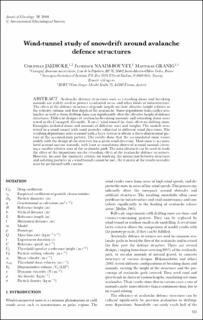Wind-tunnel study of snowdrift around avalanche defence structures
Journal article
Permanent lenke
https://hdl.handle.net/11250/3098803Utgivelsesdato
2004Metadata
Vis full innførselSamlinger
- NGI articles [1061]
Originalversjon
10.3189/172756404781814799Sammendrag
Avalanche defence structures such as retarding dams and breaking mounds are widely used to protect residential areas and other kinds of infrastructure. The effect of the defence structures depends largely on their effective height relative to the velocity, volume and flow depth of the avalanche. Snow depositions from earlier avalanches as well as from drifting snow can significantly alter the effective height of defence structures. Different designs of avalanche-breaking mounds and retarding dams were tested in the Cemagref (Grenoble, France) wind tunnel for their effect on drifting snow. Examples included dams and mounds of different sizes and heights. The models were tested in a wind tunnel with sand particles subjected to different wind directions. The resulting depositions were scanned with a laser system to obtain a three-dimensional picture of the accumulation pattern. The results show that the accumulated snow varies widely with the design of the structure for a given wind direction. Most snow is accumulated around narrow mounds, with least accumulation observed around mounds covering a smaller relative area of the avalanche path. The data obtained can be used to study the effect of the depositions on the retarding effect of the avalanche defence structures. However, because the similarity criteria for studying the interaction between structures and saltating particles in a wind tunnel cannot be met, the transfer of the results to reality must be performed with caution.
